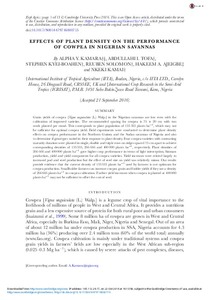| dc.contributor.author | Kamara, A. |
| dc.contributor.author | Tofa, A.I. |
| dc.contributor.author | Kyei-Boahen, S. |
| dc.contributor.author | Solomon, R. |
| dc.contributor.author | Ajeigbe, Hakeem A. |
| dc.contributor.author | Kamai, N. |
| dc.date.accessioned | 2019-12-04T11:04:14Z |
| dc.date.available | 2019-12-04T11:04:14Z |
| dc.date.issued | 2016 |
| dc.identifier.citation | Kamara, A., Tofa, A.I., Kyei-Boahen, S., Solomon, R., Ajeigbe, H.A. & Kamai, N. (2016). Effects of plant density on the performance of cowpea in Nigerian Savannas. Experimental Agriculture, 1-13. |
| dc.identifier.issn | 0014-4797 |
| dc.identifier.uri | https://hdl.handle.net/20.500.12478/1373 |
| dc.description | Article purchased; Published online: 21 October 2016 |
| dc.description.abstract | Grain yields of cowpea [Vigna unguiculata (L.) Walp.] in the Nigerian savannas are low even with the cultivation of improved varieties. The recommended spacing for cowpea is 75 × 20 cm with two seeds planted per stand. This corresponds to plant population of 133333 plants ha−1, which may not be sufficient for optimal cowpea yield. Field experiments were conducted to determine plant density effects on cowpea performance in the Northern Guinea and the Sudan savannas of Nigeria and also to determine if genotypes varied in their response to plant density. Four cowpea varieties with contrasting maturity duration were planted in single, double and triple rows on ridges spaced 75 cm apart to achieve corresponding densities of 133333, 266666 and 400000 plants ha−1, respectively. Plant densities of 266666 and 400000 plants ha−1 gave higher crop performance in terms of light interception, biomass production, yield and yield components for all cowpea varieties. Yield increases were related largely to increased pod and seed production but the effect of seed size on yield was relatively minor. Our results provide evidence that the current density of 133333 plants ha−1 used by farmers is not optimum for cowpea production. Smallholder farmers can increase cowpea grain and fodder yields if they use a density of 266666 plants ha−1 in cowpea cultivation. Further yield increases when cowpea is planted at 400000 plants ha−1 may not be sufficient to offset the cost of seed. |
| dc.format.extent | 1-13 |
| dc.language.iso | en |
| dc.subject | Cowpeas |
| dc.subject | Crop Protection |
| dc.subject | Planting |
| dc.subject | Grain Legumes |
| dc.subject | Plant Density |
| dc.title | Effects of plant density on the performance of cowpea in Nigerian Savannas |
| dc.type | Journal Article |
| dc.description.version | Peer Review |
| cg.contributor.crp | Grain Legumes |
| cg.contributor.affiliation | International Institute of Tropical Agriculture |
| cg.contributor.affiliation | International Crops Research Institute for the Semi-Arid Tropics |
| cg.coverage.region | Africa |
| cg.coverage.region | West Africa |
| cg.coverage.country | Nigeria |
| cg.isijournal | ISI Journal |
| cg.authorship.types | CGIAR multi-centre |
| cg.iitasubject | Cowpea |
| cg.iitasubject | Grain Legumes |
| cg.journal | Experimental Agriculture |
| cg.howpublished | Formally Published |
| cg.accessibilitystatus | Open Access |
| local.dspaceid | 79514 |
| cg.targetaudience | Scientists |
| cg.identifier.doi | https://doi.org/10.1017/S0014479716000715 |

